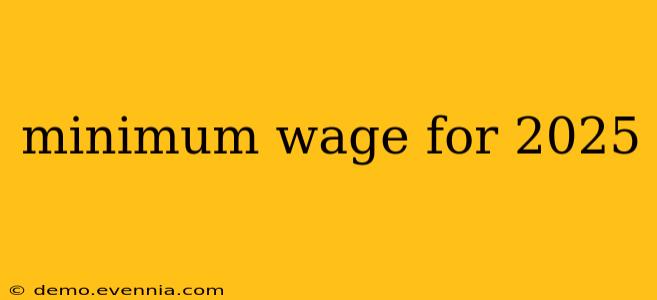The minimum wage in the United States is a complex and constantly evolving issue. Unlike many countries with a single, federally mandated minimum wage, the US system allows for significant variation between states and even some cities and counties. Predicting the minimum wage for 2025 requires analyzing current trends, proposed legislation, and economic factors. This article provides a comprehensive overview, acknowledging the inherent uncertainties involved in any future prediction.
Understanding the Current Landscape
Currently, the federal minimum wage remains at $7.25 per hour, a level unchanged since 2009. However, many states and localities have implemented their own minimum wages, often exceeding the federal standard. Some states have even established automatic increases tied to inflation or other economic indicators. This creates a patchwork of minimum wage laws across the country, leading to significant discrepancies in compensation depending on location.
Key Factors Influencing Minimum Wage Changes
Several factors influence changes in minimum wage legislation:
-
Political Climate: The political landscape significantly impacts minimum wage debates. Pro-labor movements and progressive political parties often advocate for increases, while some business groups and conservative voices express concerns about the economic consequences.
-
Economic Conditions: Inflation, unemployment rates, and overall economic growth play a crucial role. During periods of strong economic growth, arguments for minimum wage increases often gain traction, while economic downturns can lead to more cautious approaches.
-
Public Opinion: Shifting public sentiment towards minimum wage policies significantly influences legislative action. Increased awareness of income inequality and the struggles of low-wage workers can drive support for higher minimum wages.
-
Cost of Living: The cost of living in different regions varies drastically. States with higher costs of living often justify higher minimum wages to ensure a livable income for their residents.
State-Specific Minimum Wage Projections for 2025: Challenges and Uncertainties
Predicting the minimum wage for each state in 2025 is challenging due to the aforementioned factors. While some states have mechanisms for automatic increases, others rely on legislative action, making accurate predictions difficult. Several states are likely to see increases through either automatic adjustments or new legislation, but the exact amounts are uncertain. The following points highlight this challenge:
-
Legislative Unpredictability: State legislatures may introduce and pass bills that alter minimum wage levels at any point. Unexpected political shifts or changes in economic priorities could dramatically affect these levels.
-
Economic Volatility: Unforeseen economic downturns or inflationary pressures could influence decisions regarding minimum wage increases, potentially leading to slower-than-anticipated growth or even temporary freezes.
-
Legal Challenges: Minimum wage laws can face legal challenges, delaying implementation or even leading to reversals. These challenges can add significant uncertainty to projections.
Potential Future Trends
Despite the inherent uncertainties, some broader trends might shape the minimum wage landscape in 2025:
-
Increased Calls for Federal Action: Pressure for a significant increase in the federal minimum wage is likely to persist, potentially leading to renewed legislative efforts at the national level. Even if a federal increase doesn't materialize, it will continue to impact state-level debates.
-
Regional Disparities: Expect the gap between minimum wages in high-cost-of-living areas and those in lower-cost areas to remain significant, reflecting ongoing regional economic differences.
-
Focus on Living Wages: The concept of a "living wage"—a wage sufficient to meet basic needs—will continue to drive advocacy efforts, influencing minimum wage discussions and potentially leading to higher minimums in some locations.
Conclusion
Predicting the exact minimum wage for each state in 2025 is inherently speculative. The dynamic interplay of political, economic, and social factors makes definitive predictions impossible. However, understanding the current landscape and the key factors driving change allows for a more informed perspective on potential future trends. This article serves as a starting point for ongoing research and monitoring of minimum wage developments in your specific location. Regularly checking your state's labor department website for updates is crucial to staying informed.

